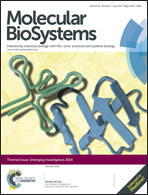An orphan two-component response regulator Slr1588 involves salt tolerance by directly regulating synthesis of compatible solutes in photosynthetic Synechocystis sp. PCC 6803†
Abstract
We report here the characterization of a novel orphan response regulator Slr1588 directly involved in the synthesis and transport of compatible solutes against salt stress. In the Δslr1588 mutant, salt tolerance was found to be decreased by 2–3-fold. Using a high performance Q-EXACTIVE hybrid quadrupole-Orbitrap mass spectrometer, we found that proteins involved in the synthesis and transport of glucosylglycerol, a key compatible solute, were up-regulated in the Δslr1588 mutant grown in 4.0% NaCl, suggesting that Slr1588 might function as a repressor for glucosylglycerol metabolism. The functional assignment was further confirmed using an electrophoretic mobility shift assay (EMSA) showing that the purified his-tagged Slr1588 could bind in vitro directly to the upstream regions of sll1566 (ggpS) genes required for glucosylglycerol biosynthesis. In addition, quantitative proteomic analysis showed that the biosynthesis of another key compatible solute in Synechocystis, sucrose, was also up-regulated in the Δslr1588 mutant under 4.0% NaCl, and EMSA showed that the purified his-tagged Slr1588 bound in vitro directly to the upstream regions of sll0045 (spsA) gene required for sucrose biosynthesis. Moreover, proteomic analysis showed that 113 and 127 unique proteins were and up- and down-regulated in the Δslr1588 mutant grown under 4.0% NaCl, respectively. Notably, a dozen transporter genes were down-regulated in the Δslr1588 mutant under salt stress. The study revealed a novel salt-tolerant regulatory mechanism mediated by Slr1588, and also provided a proteomic description of the possible Slr1588 regulon in Synechocystis.


 Please wait while we load your content...
Please wait while we load your content...